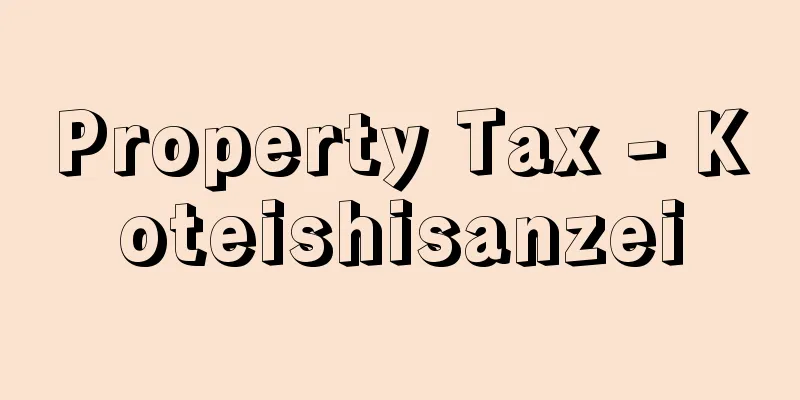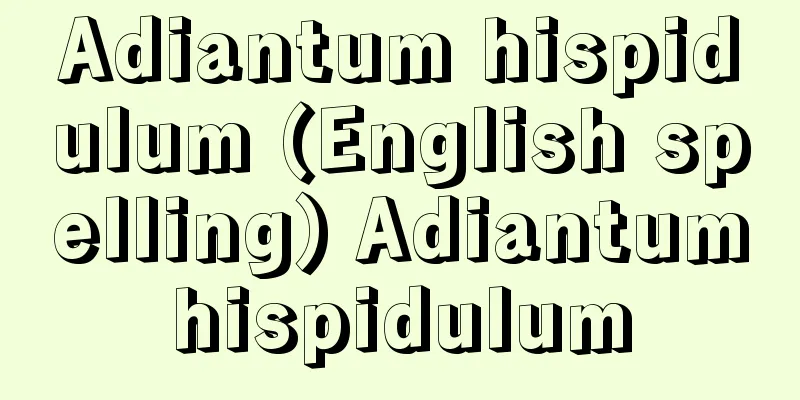Property Tax - Koteishisanzei

|
A normal tax levied by municipalities on land, buildings and depreciable assets in principle (levied by Tokyo Metropolitan Government within special wards). A type of nominal property tax levied based on the value of assets. Its tax revenue is large, on a par with municipal inhabitant taxes. It is considered the most suitable tax item for municipal taxes in terms of universality, stability and benefit-based nature. Taxation on land has long been levied as a national land tax, and local governments have imposed a land tax surcharge on this, but in 1940 (Showa 15), it was decided that the entire amount would be returned as a refund tax to the prefecture where it was collected. In 1947, it was made an independent prefectural tax. Taxation on houses, which was established as a house tax as an optional tax to replace the prefecture's per household tax, was made a national tax in 1940, and the entire amount was refunded to the prefecture where it was collected. This also became an independent prefectural tax in 1947. Taxation on depreciable assets has also been levied individually for a long time. With the revision of the local tax system based on the Shoup recommendations in 1950, taxes on land, houses, and depreciable assets were integrated into the fixed property tax, which was newly established as a municipal tax. In principle, municipalities are the taxing bodies, but for large-scale depreciable assets, municipalities are required to tax up to a certain limit of the value, and the prefecture that includes the municipality has the right to tax any portion exceeding that limit. The taxpayer is the owner of the fixed assets, but a wide range of tax exemptions are available, focusing on the characteristics of the owner of the fixed assets and the characteristics and uses of the fixed assets. The tax base is set at the fair market value, but for land and buildings, revaluation is carried out once every three years, and unless there is a change in land use or an extension or renovation of a building, the assessed value for the base year is kept unchanged for three years. In 1964, the assessment system was revised, and the assessed value was far removed from the market value, resulting in noticeable disparities between municipalities. In order to correct this, the assessment method was unified across all municipalities. However, this resulted in a sharp increase in the burden, especially for land, and separate burden adjustment measures were taken. In addition, special measures for the assessment base are available for certain residential land and certain depreciable assets. The standard tax rate is 1.4% and the limit rate is 2.1%, and when taxation exceeds 1.7%, the city or town assembly must hear the opinion of the taxpayer. The tax exemption points are 300,000 yen for land, 200,000 yen for buildings, and 1.5 million yen for depreciable assets. In order to promote housing construction from a taxation perspective, the fixed asset tax is reduced at the time of construction for newly built homes that meet certain requirements. [Takeshi Okawa] [Reference] | | | | | | | |Source: Shogakukan Encyclopedia Nipponica About Encyclopedia Nipponica Information | Legend |
|
土地、家屋および償却資産に対し、原則として市町村が課する普通税(特別区の区域内では、東京都が課する)。資産の価値に着目して課する一種の名目的財産税。その税収は市町村民税と並んで大きい。普遍性、安定性、応益性などの点で市町村税としてもっとも適した税目とされている。 土地に対する課税は、古くから国税の地租として行われており、地方団体はこれに地租付加税を課してきたが、1940年(昭和15)に還付税として全額が徴収地の都道府県に還付されることとなった。さらに47年には都道府県の独立税とされた。家屋に対する課税は、家屋税が都道府県の戸数割にかわるべき選択税として設けられていたのが、40年に国税とされ、その全額が徴収地の都道府県に還付されることとなった。これも47年に都道府県の独立税となった。また、償却資産に対する課税も、個別的には古くから実施されてきた。50年のシャウプ勧告に基づく地方税制の改正により、これらの土地、家屋および償却資産に対する課税が、新しく市町村税として設けられた固定資産税に統合された。 課税団体は原則として市町村であるが、大規模償却資産については、市町村はその価額のうち一定の限度額まで課税するものとされ、それを超える部分については、その市町村を包括する都道府県が課税権を有する。納税義務者は固定資産の所有者であるが、固定資産の所有者の性格や固定資産の性格・用途に着目して広範な非課税措置が講じられている。課税標準は適正な時価とされているが、土地および家屋については、3年に一度の基準年度ごとに評価替えを行って、地目の変換、家屋の増改築などがない限り、3年間基準年度の評価額に据え置く方式がとられている。1964年度に評価制度が改正され、評価額が時価とかけ離れ、市町村間で不均衡が目だってきたのを改めるため、全市町村を通じて評価の方法が統一された。しかし、これにより、とくに土地については負担が急増することとなったため、別途、負担調整措置がとられることとなった。また、一定の住宅用地や一定の償却資産については、課税標準の特例措置が講じられている。 税率は、標準税率が1.4%、制限税率が2.1%で、1.7%を超えて課税するときは、当該市町村の議会において、納税義務者の意見を聴くものとされている。免税点は、土地が30万円、家屋が20万円、償却資産が150万円である。税制面から住宅建設の促進を図るため、一定の要件を備えた新築住宅については、新築当初の固定資産税が減額される。 [大川 武] [参照項目] | | | | | | | |出典 小学館 日本大百科全書(ニッポニカ)日本大百科全書(ニッポニカ)について 情報 | 凡例 |
<<: Fixed capital, liquid capital
>>: Fixed assets - Koteishisan (English spelling) fixed assets
Recommend
Kyrene (English spelling)
A Greek colony (→Apoikia) on the coast of Libya in...
Alternative Liste Österreichs (English)
...It has been pointed out that the growing fisca...
The Hague Peace Conference
The Hague Conference was held twice, in 1899 and ...
Ezomuukashiebi - Ezomuukashiebi
…Since the first species, Bathynella natus , was ...
Amiota variegata (English spelling) Amiota variegata
…It does not refer to a specific insect, but is a...
Erysiphaceae
…Sulfur agents are a good pest control agent. [Te...
Genta Ebira
...The Genji warrior Genta Kajiwara is made into ...
Neo-Confucianism
A new Confucianism was established by Zhu Xi (Zhu...
client
…In the process, it became clear that counseling ...
relative deprivation
…In Japan, what is called the standard cost of li...
Shoyo Nakano
A Chinese poet. His real name was Shigetarou, and ...
Eigenji Temple
This is the former town area in the eastern part o...
Satsuma Nishiki (Erasmia pulchella)
An insect of the Zygaenidae family of the Lepidopt...
The Strange Case of Dr. Jekyll and Mr. Hyde
A novella by British author R.L. Stevenson. Publi...
Chenonceaux (English spelling)
A small village with a population of 358 (1982) lo...









